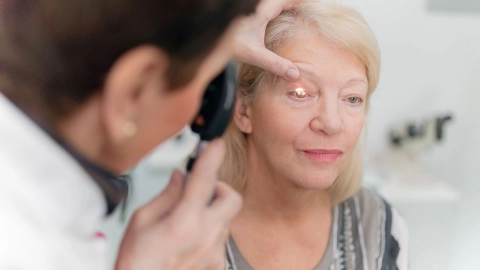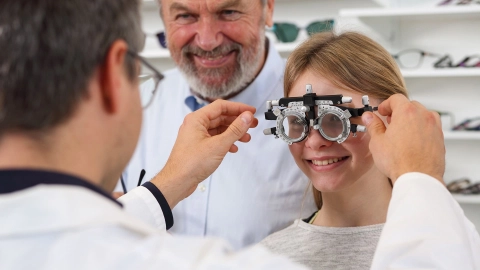Conditions Keratoconus
ICD codes: H18.6 What are ICD codes?
Keratoconus is an eye disease in which the cornea becomes distorted and gets thinner and thinner. As a result, vision declines more and more. In this article, learn how cornea distortion is detected and what can be done about it.
At a glance
- Keratoconus is an eye disease in which the cornea develops a cone-shaped bulge and becomes thinner and thinner.
- In most cases, the disease begins in adolescence or young adulthood in one eye and gradually appears in the second eye over time.
- The vision of the affected eyes continues to decline as the disease progresses.
- Contact lenses are often sufficient for treatment. When necessary, there are yet other possibilities to stop or treat the distortion of the cornea.
Note: The information in this article cannot and should not replace a medical consultation and must not be used for self-diagnosis or treatment.

What is keratoconus?
Keratoconus is a rare non-inflammatory eye disease in which the cornea of the eye becomes increasingly thin and distorted. The cornea is a thin clear membrane that usually rests closely on the eyeball. In the case of keratoconus however, it protrudes in a cone shape.
The disease often begins in one eye but affects both eyes over the course of time. Keratoconus can progress both in phases and continuously. In the course of this, vision continues to decline until the disease usually stops at the age of about 40 years.
To compensate for the declining vision, people with keratoconus normally wear glasses or contact lenses. Rapid deterioration can often be slowed or stopped by outpatient surgery.
The causes of keratoconus are unknown. But there are factors that encourage distortion of the cornea.
What are the symptoms of keratoconus?
Sensitivity to light and blurred and distorted vision can be the first signs of keratoconus.
It is typical for vision to change frequently and for repeated corrections of lens strength or a readjustment of contact lenses to be necessary.
One eye is very often more severely affected than the other. Some people with keratoconus are especially sensitive to light.
Sometimes there are also structural changes in the eye such as yellow-brown lines or a greenish-brownish ring at the edge of the cornea.
Advanced keratoconus may be outwardly visible. In that case, the lower eyelid develops a cone-shaped distortion that can be seen by the naked eye.
What factors increase the risk of keratoconus?
The cause of the disease is unknown, but it is presumed that the following factors encourage keratoconus:
- recurrent injuries to the cornea, for instance due to constantly rubbing the eyes or ill-fitting hard contact lenses
- genetic predisposition: about 6 to 8% of people with keratoconus have relatives who also have the disease
- allergies
- connective tissue diseases
Furthermore, people with Down’s Syndrome (Trisomy 21) develop keratoconus more frequently.
How common is keratoconus?
Keratoconus is one of the most common diseases of the cornea. About one out of every 2,000 people develop this disease every year.
At what age does keratoconus occur?
For young men, the eye disease usually begins when they are teenagers, while for women, it starts in their early 20s. Only rarely does keratoconus occur later as a result of a hormone change, for instance during pregnancy or menopause.
About 20 years after it begins, the disease often stops, usually at around the age of 40.
Keratoconus normally affects both eyes. But it does not have to be equally pronounced in both eyes. It is possible for one eye to remain symptom-free.
How is keratoconus diagnosed?
A normal eye examination is not usually enough to detect keratoconus in its early stage. It is often initially thought to be an astigmatism, a commonly occurring irregularity of the cornea.
If vision is strongly variable or blurred despite corrective lenses being worn, a precise measurement of the cornea is expedient. For this, doctors use what is commonly called corneal topography or optical coherence tomography (OCT).
With these examinations, the thickness and quality of the cornea can be detected, along with cell changes and clouding.
How is keratoconus treated?
The treatment of keratoconus depends on the stage and how the disease progresses afterward. If the keratoconus is stable, having only changed slightly or not at all, the defective vision in particular is corrected. If it quickly deteriorates, attempts are made to stop this.
Initially, glasses or contact lenses may compensate for the defective vision.
In particular, dimensionally stable (hard) contact lenses often produce good vision again, but not all people can tolerate them. In that case, special lenses like hybrid or scleral lenses are sometimes considered.
Eye specialists can stop further protrusion of the cornea with a process called UV-riboflavin crosslinking. For this, they initially remove the topmost layer of the cornea after a local anesthesia and then apply a liquid with the vitamin riboflavin to the eye. Due to subsequent irradiation with UV-A light, the connective tissue collagen fibers inside the cornea are crosslinked, which stabilizes them.
While this method does not in fact correct the visual impairment, it does slow its progression. In an early stage especially, it often helps prevent vision from getting worse.
If the cornea has become too thin in the event of advanced keratoconus, UV-riboflavin crosslinking is no longer an option. With severe symptoms, a corneal transplantation is then possible. In this connection, the patient’s own cornea is partially or wholly replaced by a donor cornea (keratoplasty).
What should you look out for in everyday life with keratoconus?
People with keratoconus should avoid constantly rubbing their eyes as far as possible. With dry eyes or irritation, moisturizing eye drops can provide relief.
With hay fever and other allergies that cause eye irritation, it is moreover important to treat the allergy symptoms with appropriate medications.
- Asimellis G, Kaufman EJ. Keratoconus. 2020 Dec 28. In: StatPearls [Internet]. Treasure Island (FL): StatPearls Publishing; 2021 Jan-. Aufgerufen am 02.07.2021.
- DynaMed (Internet), Ipswich (MA): Keratoconus. EBSCO Information Services. Record No. T920564. 2018 (1995). Aufgerufen am 02.07.2021.
- Stiftung für Qualität und Wirtschaftlichkeit im Gesundheitswesen. UV-Vernetzung mit Riboflavin bei Keratokonus. Aufgerufen am 02.07.2021.
- UpToDate (Internet). Keratoconus. Wolters Kluwer 2020. Aufgerufen am 02.07.2021.
In cooperation with the Institute for Quality and Efficiency in Health Care (Institut für Qualität und Wirtschaftlichkeit im Gesundheitswesen – IQWiG).
As at:



